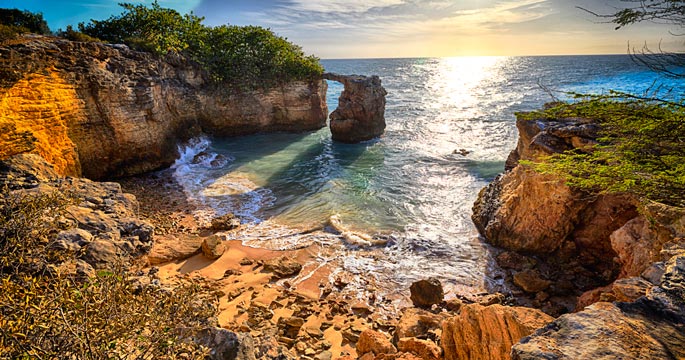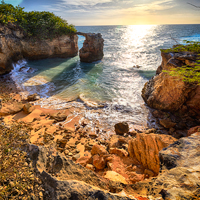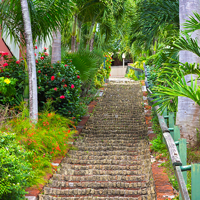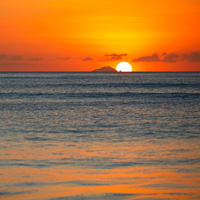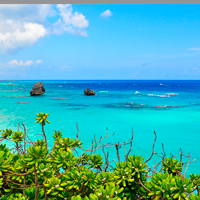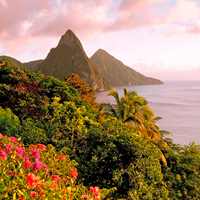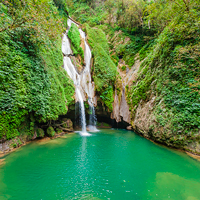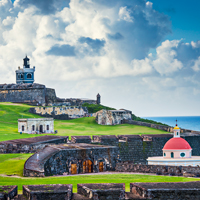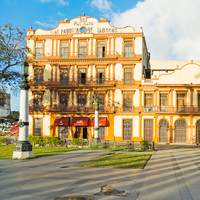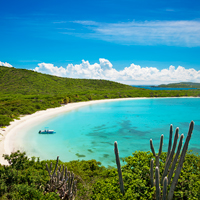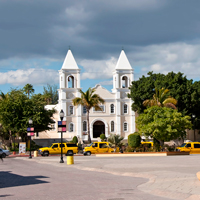Quaint, yet cosmopolitan. Bermuda is a vacation destination that draws visitors from both sides of the Atlantic. Traditions such as high tea, croquet lawns and afternoon cricket matches blend with modern recreations ranging from golf to scuba diving. History buffs have forts and lighthouses to discover and the beaches are some of the best in the world. Top that with a warm and friendly population whose cultural mix include British, West Indian and a touch of Portuguese and you have a destination that everyone loves and no one wants to leave.
1 Go Coastal
While pink beaches are the island’s trademark, some stretches of coastline are actually covered in soft, creamy-white sand that is just as striking when set against the electric blue waters. Coastlines are punctuated by coves, etched out caves and natural arches formed by centuries of wave erosion. Exploring the coastlines is always interesting and adventurous as you climb over rugged ledges and rocky formations for expansive ocean views.
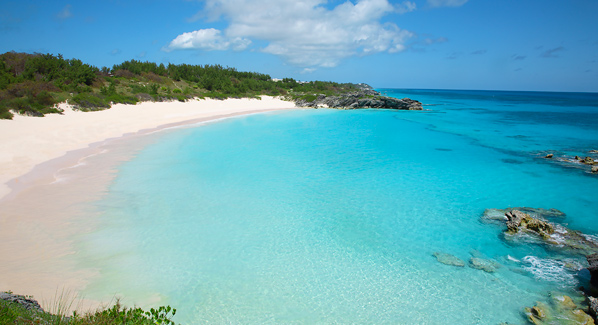
The pink sands of Horseshoe Beach are sheltered by rocky headlands and a fringing reef. This is one of Bermuda’s most popular beaches, and a favorite destination for snorkelers. Photo: Todd Taulman/iStock
2 Maritime History
The vision of the British was to make Bermuda the Gibraltar of the west. Construction of the Royal Naval Dockyard began in 1809. This sprawling 75-acre complex was intended as a base to defend the British colonies and to attack American forces. Built by slaves and convicts, the stonewalls surrounding the yards once housed ammunition and barracks. Today you still enter the Dockyard via stone gates, but inside there are shops, restaurants and galleries along with the Bermuda Maritime Museum.
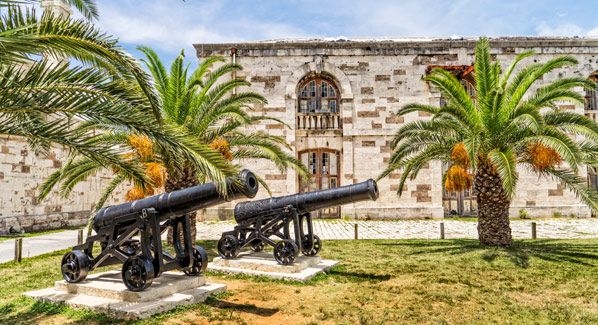
Bermuda’s Royal Naval Dockyard was once an important British military port. Today, the expansive grounds and resorted buildings are a favorite destination for sightseers. Photo: Gerald LaFlamme/iStock
3 The Magic Bus
Bermuda’s bus system is second to none. Known as the Bermuda Breeze, these pink-and-blue coaches are the primary means of transport for locals and visitors alike, and run from one end of the island to the other. The buses are spotlessly clean, run on a schedule and are a perfect place to chat, meet locals and other visitors. More than just a driver, the man behind the wheel is an ambassador for the island.
4 Pristine Properties
Bermuda may be the cleanest island in the world. The island villages are quaint and tidy, as Bermudians take great pride in their property. You’ll notice manicured green lawns and gardens full of blooms; some homes have a vegetable plot arranged so perfectly that it could be featured in a gardening magazine. Stone walls separate properties and orchards and are covered in spider lilies and flowering vines. Homes are tinted in a collection of water taffy pastels. You’ll see lime green, sky blue, lemon yellow and raspberry pink, all topped with stark white limestone roofs.
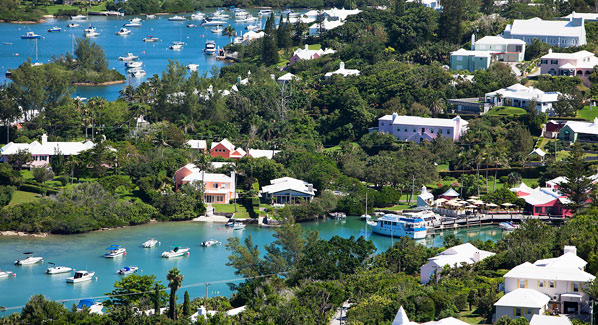
Though often referred to as the island of Bermuda, this British Overseas Territory is actually composed of 138 separate landmasses, most connected by a network of bridges and roadways with tidy villages. Photo: iStock
5 Top-notch Sleepovers
No mater where you check in, you won’t find a tattered, run down or even a run-of-the-mill resort on the island. Choices range from elegant and historic beach hideaways where guests are indulged in food, wine and white glove service to cottage colonies where you feel more like a resident than a hotel guest. These cottage compounds are unique to Bermuda and date back to an era when guests came for extended summer stays. Stay in a cottage on the grounds of a resort and you can enjoy both privacy and the conveniences of on-site restaurants, lounges, and recreational amenities.
6 Tee time
Bermuda has more golf courses per square mile than any other island, including several that are ranked as among the best in the world. Some courses offer spectacular views of the ocean from elevated tees and hilltop clubs, while others such as Belmont Hills have panoramic views of Hamilton Harbour and the Great Sound. Those looking for a memorable challenge can take on two of golf’s most legendary holes: the Mid Ocean Club’s intimidating fourth, known as the Cape, and the spectacular oceanside par-3 16th at Port Royal.
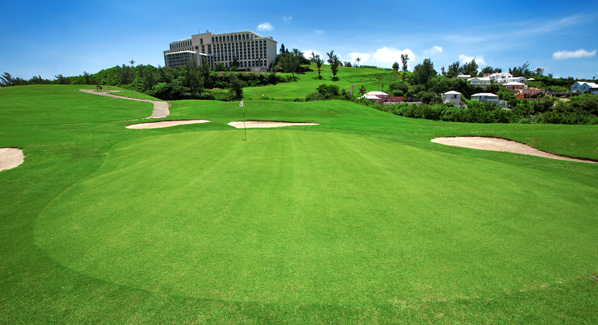
The Turtle Hill Golf Club at the Fairmont Southampton has been ranked among the top par-3 courses in the world. Bermuda offers seven golf courses, including several of championship quality. Photo: iStock
7 Men in Shorts
Nowhere else in the world can men go to business meetings in shorts. No, not beach shorts, but stylish, pressed Bermuda shorts. Proper business attire states that shorts cannot be more than two inches above the knee and should have a two-inch hem. The entire ensemble includes leather shoes—preferable loafers— worn with matching or coordinating knee socks and a long sleeve shirt, tie and jacket. Add a briefcase and you’ve got your power executive. The shorts started as a result of offering businessmen a respite from the warm summers and today are worn in the colors of Bermuda: lime green, pink and lemon yellow—with matching socks, of course.
8 World of Goods
The island is a crossroads for international maritime commerce. During the American Civil War, Bermuda traders ran supplies through the North’s blockades of Southern ports. Today international commerce centers around the capital of Hamilton. Front Street is lined with shops selling imports from around the world. You can stock up on Lalique and Wedgewood along with Irish linens, Scottish Tweeds, Swiss watches, Cuban cigars and Italian silk scarfs all duty free. Local artwork includes hand-blown glass, pottery, paintings and sculptures which can be found in Hamilton and shops at the Dockyard.
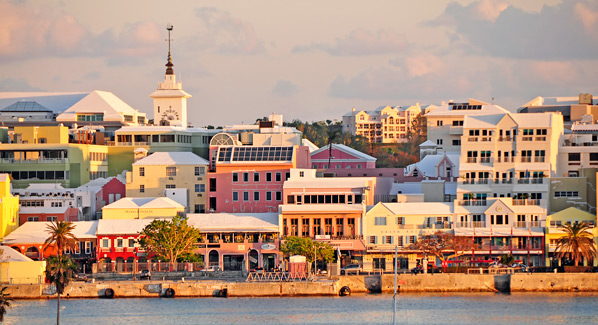
Bermuda’s capital city, Hamilton, is both a major international center and a popular port of call. Front Street faces the harbor, and is lined by a collection of popular shops and cafes. Photo: iStock
9 Think Pink
The color of Bermuda is pink. Everywhere you look you’ll find a shade of blush, rose or coral brushed on a building, used in a logo and in articles of clothing. Men, in particular, wear a lot of the color and most have a pair of pink Bermuda shorts in their wardrobe. The various tones of pink are a reflection of the natural beauty of the island, its pink sand beaches and pink sunsets.
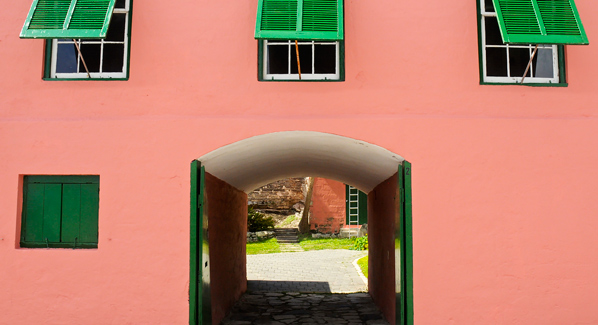
This traditional building displays Bermuda’s signature pink hue, and reflects a time before air conditioning, when breezeways and overhangs capitalized on cooling breezes. Photo: Megan Morgan/iStock
10 Wrecking Crew
The treacherous reefs surrounding the island have claimed many a ship. Today Bermuda is known as a wreck diving mecca, with more than 400 vessels sunk off its coastlines. There are 16th- century Spanish galleons, merchant steamers from the 1800s and decommissioned freighters intentionally sunk for reef building purposes. The largest wreck is the Cristobal Colon, a 500-foot luxury liner. Most wrecks are in relatively shallow water, and are easily reached by several dive operators.

